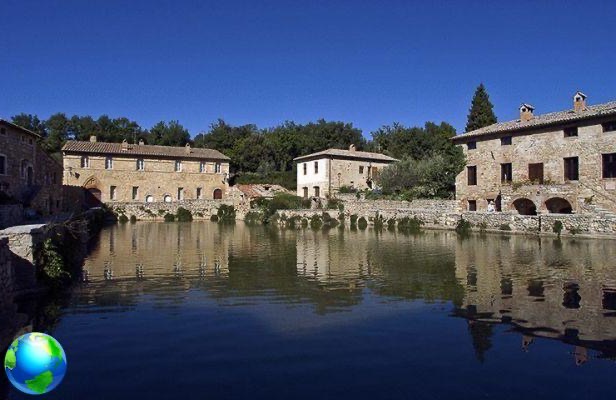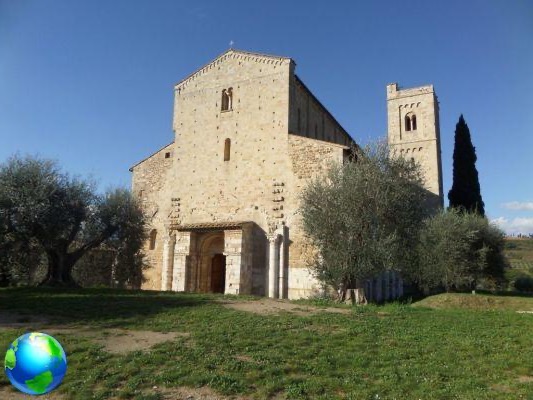Val d'Orcia, itinerary in Tuscany to discover an area of extraordinary beauty, from Pienza to Castiglione d'Orcia and Radicofani, up to Montalcino and San Quirico, read here what to do and what to see.
If the Val d'Orcia is the summa of the Tuscan landscape, the Val d'Orcia in spring is an absolute must. At no other time of the year are the lines of the hills so brilliant and the slender shape of the cypresses is drawn with such elegance. But what do we mean when we talk about Val d'Orcia? This is a portion of territory south of Siena, between the Val di Chiana, Monte Amiata and the Metalliferous Hills, that was declared by UNESCO world Heritage.
Val d'Orcia boasts some world-famous locations such as Montalcino, Pienza or Bagno Vignoni, but it is made up of five interesting towns among which a dream landscape stretches out: the municipalities are San Quirico d'Orcia, Pienza, Montalcino, Radicofani and Castiglione d'Orcia.

San Quirico
Wanting to follow an ideal itinerary, which starts from Siena, going south on the Cassia (SR 2) you reach San Quirico, which is a town worth visiting. The historic center is small but with the Collegiate Church of San Quirico and Santa Giuditta (simple and elegant) and above all with the famous Horti Leonini it gives satisfactions to those in search of art. The Italian gardens called Horti Leonini date back to 1540.
However it is in the territory of San Quirico that there are some places, true icons of the idea of Tuscany. Not far from the center continuing on the Cassia here Vignoni bathroom, the spa village with the majestic, incredible square consisting of a swimming pool of hot water, steaming in winter and summer. Bathing in the square is prohibited, but there are plenty of spas, for a daily entrance or for a stay. The territory of San Quirico is also the one that preserves the incredible beauty of Chapel of the Madonna of Vitaleta, a Renaissance church flanked by two cypresses in the rolling green hills. An image that we have seen in a thousand photos and which is in the original right here.

Pienza
If you have passed by Vitaleta you are going towards Pienza, a small gem of a city whose monuments have been photographed and filmed in photos and films (not least the I Medici series). The ideal city of Enea Silvio Piccolomini is entirely Renaissance, has an incredibly elegant and harmonious Piazza Duomo between the Cathedral and Palazzo Piccolomini; it stands on a hill and it is precisely from the loggia of the Palazzo that it dominates the landscape of Val d'Orcia, the hills now covered with green grass. A moving beauty.

Castiglione d'Orcia and Radicofani
Two places perhaps less known, but that you can include in the itinerary. Castiglione d'Orcia now borders on the woods of Mount Amiata, the ancient extinct volcano with its unequivocal conical shape, which straddles the territory of Siena and Grosseto. Radicofani, in the far south, is an austere-looking fortress that has represented for centuries the border point between Tuscany and the Papal State. From the top of the tower on spring days the gaze sweeps up to Lake Bolsena and the Apennines.
Wanting to make a thermal detour you are now close to San Casciano dei Bagni, where hot waters are "dispensed" in the elegant Fonteverde establishment, but also in tubs for free use: for "low cost" spa treatments, indeed totally free, there are both Large bathroom, with a fantastic natural whirlpool produced by jets and gaseous bubbles that come to the surface from the thermal source, both the Bossolo bathroom, which has a milder water temperature than the others.

Montalcino
It is necessary to move west again to reach Montalcino, the production area of Brunello. The town is very ancient, with a fortress all surrounded by walls: its strongest appeal is wine, but if you want to go gourmet shopping you must not forget the pecorino cheese which is of superior quality in these parts.
From Montalcino you can reach a magical place in the Val d'Orcia, theAbbey of Sant'Antimo, isolated in the countryside and place of life and prayer of a community of monks of the Benedictine monastic community of Santa Maria di Monte Oliveto Maggiore (located in Asciano, also in the Sienese area). The Abbey dates back to the 11th century and is in French Romanesque forms; built in local travertine and alabastrite onyx, it gives the building a very special brightness. The community is active and dedicated - according to the rule of St. Benedict - to work and prayer: if you are lucky enough to enter the course of the recitation of the psalms you can breathe deeply the mysticism that exudes from this place.


























